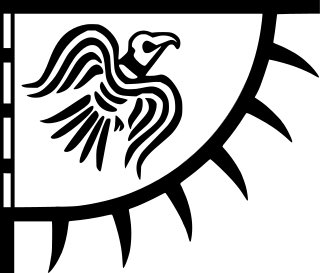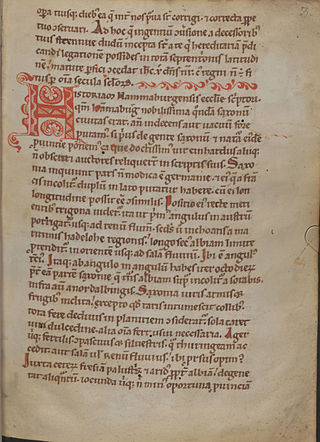Related Research Articles

The Orkneyinga saga is a narrative of the history of the Orkney and Shetland islands and their relationship with other local polities, particularly Norway and Scotland. The saga has "no parallel in the social and literary record of Scotland" and is "the only medieval chronicle to have Orkney as the central place of action". The main focus of the work is the line of jarls who ruled the Earldom of Orkney, which constituted the Norðreyjar or Northern Isles of Orkney and Shetland and there are frequent references to both archipelagoes throughout.

Saint Magnus Erlendsson, Earl of Orkney, sometimes known as Magnus the Martyr, was Earl of Orkney from 1106 to about 1117.

Earl of Orkney, historically Jarl of Orkney, is a title of nobility encompassing the archipelagoes of Orkney and Shetland, which comprise the Northern Isles of Scotland. Originally founded by Norse invaders, the status of the rulers of the Northern Isles as Norwegian vassals was formalised in 1195. Although the Old Norse term jarl is etymologically related to "earl", and the jarls were succeeded by earls in the late 15th century, a Norwegian jarl is not the same thing. In the Norse context the distinction between jarls and kings did not become significant until the late 11th century and the early jarls would therefore have had considerable independence of action until that time. The position of Jarl of Orkney was eventually the most senior rank in medieval Norway except for the king himself.
Thorfinn Torf-Einarsson also known as Thorfinn Skull-splitter was a 10th-century Earl of Orkney. He appears in the Orkneyinga saga and briefly in St Olaf's Saga, as incorporated into the Heimskringla. These stories were first written down in Iceland in the early 13th century and much of the information they contain is "hard to corroborate".

The Earldom of Orkney is the official status of the Orkney Islands, and was a Norse territory ruled by the earls of Orkney from the ninth century until 1472. It was founded during the Viking Age by Viking raiders and settlers from Scandinavia. In the ninth and tenth centuries it covered the Northern Isles (Norðreyjar) of Orkney and Shetland, as well as Caithness and Sutherland on the mainland. It was a dependent territory of the Kingdom of Norway until 1472, when it was absorbed into the Kingdom of Scotland. Originally, the title of Jarl or Earl of Orkney was heritable.
Thorfinn Sigurdsson, also known as Thorfinn the Mighty, was an 11th-century Jarl of Orkney. He was the youngest of five sons of Jarl Sigurd Hlodvirsson and the only one resulting from Sigurd's marriage to a daughter of Malcolm II of Scotland. He ruled alone as jarl for about a third of the time that he held the title and jointly with one or more of his brothers or with his nephew Rögnvald Brusason for the remainder. Thorfinn married Ingibiorg Finnsdottir, daughter of Finn Arnesson, Jarl of Halland.
Sigurd Hlodvirsson, popularly known as Sigurd the Stout from the Old Norse Sigurðr digri, was an Earl of Orkney. The main sources for his life are the Norse Sagas, which were first written down some two centuries or more after his death. These engaging stories must therefore be treated with caution rather than as reliable historical documents.

The Bishop of Orkney was the ecclesiastical head of the Diocese of Orkney, one of thirteen medieval bishoprics of Scotland. It included both Orkney and Shetland. It was based for almost all of its history at St Magnus Cathedral, Kirkwall.

The Mormaer of Caithness was a vassal title mostly held by members of the Norwegian nobility based in Orkney from the Viking Age until 1350. The mormaerdom was held as fief of Scotland and the title was frequently held by the Norse Earls of Orkney, who were thus a vassal of both the King of Norway and the King of Scots. There is no other example in the history of either Norway or of Scotland in which a dynasty of earls owed their allegiance to two different kings.
Brusi Sigurdsson was one of Sigurd Hlodvirsson's four sons. He was joint Earl of Orkney from 1014. His life is recorded in the Orkneyinga Saga.
Alexander Gordon was a 16th-century Scottish churchman who was successively archbishop of Glasgow, titular archbishop of Athens, bishop of the Isles and bishop of Galloway.

Gesta Hammaburgensis ecclesiae pontificum is a historical treatise written between 1073 and 1076 by Adam of Bremen, who made additions (scholia) to the text until his death . It is one of the most important sources of the medieval history of Northern Europe, and the oldest textual source reporting the discovery of coastal North America.
William the Old was a 12th-century prelate who became one of the most famous bishops of Orkney. Although his origins are obscure in detail, William was said to have been a "clerk of Paris". Saga tradition had it that William had been bishop for 66 years when he died in 1168, meaning that his accession to the bishopric would have been around 1102. There is no contemporary evidence of his episcopate until a letter of Pope Honorius II in 1128, which even then does not name William specifically, but rather only mentions a bishop holding office at the same time as Radulf Novell. He was however definitively in charge by December 1135 during the earldom of Earl Paul Haakonsson.
Reinald Macer [also called Reginald] was a medieval Cistercian monk and bishop, active in the Kingdom of Scotland during the reign of William the Lion. Originally a monk of Melrose Abbey, he rose to become Bishop of Ross in 1195, and held this position until his death in 1213. He is given the nickname Macer in Roger of Howden's Chronica, a French word that meant "skinny".
Karl Hundason, also Karl Hundisson, is a personage in the Orkneyinga Saga. The saga recounts a war between Thorfinn Sigurdsson, Earl of Orkney, and Karl, whom it calls king of Scots. The question of his identity and historicity has been debated by historians of Scotland and the Northern Isles for more than a century. However a literal translation suggests that the name may simply be an insult.
Ragnhild Eriksdotter was the daughter of Eric Bloodaxe and his wife, Gunnhild. According to the Orkneyinga Saga, she was an ambitious and scheming woman who sought power through the men of the family of Thorfinn Torf-Einarsson, who was Earl of Orkney. The period after Thorfinn's death was one of dynastic strife.
John was an 11th-century prelate. According to the Saxon writer Adam of Bremen, historian of the archbishops of Hamburg, John was sent to Orkney by Adalbert, Archbishop of Hamburg, to succeed Thorulf as Bishop of Orkney. According to Adam, he had previously been consecrated as a bishop in "Scotland".
Adalbert was an 11th-century prelate. Having been consecrated elsewhere, he is said by the Saxon writer Adam of Bremen to have been sent to become Bishop of Orkney by his namesake, Adalbert, Archbishop of Hamburg. He is mentioned as the successor of Bishop John.

Scandinavian Scotland was the period from the 8th to the 15th centuries during which Vikings and Norse settlers, mainly Norwegians and to a lesser extent other Scandinavians, and their descendants colonised parts of what is now the periphery of modern Scotland. Viking influence in the area commenced in the late 8th century, and hostility between the Scandinavian earls of Orkney and the emerging thalassocracy of the Kingdom of the Isles, the rulers of Ireland, Dál Riata and Alba, and intervention by the crown of Norway were recurring themes.
Helga Moddansdóttir was the mistress of Haakon Paulsson who was Earl of Orkney from 1105 to 1123.
References
- Anderson, Alan Orr, ed. (1922), Early Sources of Scottish History A.D. 500 to 1286 (2 vols), Edinburgh: Oliver and Boyd
- Cant, Ronald G. (1972), "The Church in Orkney and Shetland and Its Relations with Norway and Scotland in the Middle Ages", Northern Scotland: A Historical Journal, Aberdeen: University of Aberdeen Centre for Scottish Studies, 1: 1–18
- Crawford, Barbara E. (1983), "Birsay and the Early Earls and Bishops of Orkney", Orkney Heritage: Vol. 2: Birsay: A Centre of Political and Ecclesiastical Power (Papers delivered to the 1982 Birsay Conference), Kirkwall: Orkney Heritage Society: 97–118
- Crawford, Barbara E. (1993), "Birsay-Peel-Selja: Three Norse Bishops' Seats on Off-Shore Islands, A Comparative Study", Kirkearkeologi og Kirkekunst: Studier Tilegnet Sigrid og Håkon Christie , Oslo: Alvheim & Eide, pp. 21–36, ISBN 82-90359-60-8
- Crawford, Barbara E. (1996), "Bishops of Orkney in the Eleventh and Twelfth Centuries: Bibliography and Biographical List", Innes Review, 47 (1): 1–13, ISSN 0020-157X
- Crawford, Barbara E. (1987), Scandinavian Scotland, Studies in the Early History of Britain: Scotland in the Early Middle Ages • 2, Leicester: Leicester University Press, ISBN 0-7185-1197-2
- Dowden, John (1912), Thomson, John Maitland (ed.), The Bishops of Scotland : Being Notes on the Lives of All the Bishops, under Each of the Sees, Prior to the Reformation, Glasgow: James Maclehose and Sons
- Thomson, William P. L. (2008), The New History of Orkney (3rd ed.), Edinburgh: Birlinn, ISBN 978-1-84158-696-0
- Tschan, Francis J.; Reuter, Timothy, eds. (2002), History of the Archbishops of Hamburg-Bremen/ Adam of Bremen, Records of Western Civilization, New York: Columbia University Press, ISBN 0-231-12575-5
- Watt, D. E. R.; Murray, A. L., eds. (2003), Fasti Ecclesiae Scoticanae Medii Aevi ad annum 1638, The Scottish Record Society, New Series, Volume 25 (Revised ed.), Edinburgh: The Scottish Record Society, ISBN 0-902054-19-8, ISSN 0143-9448